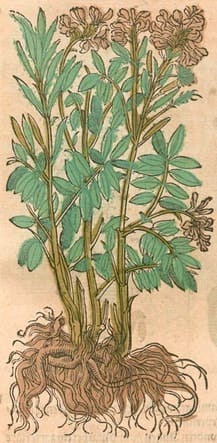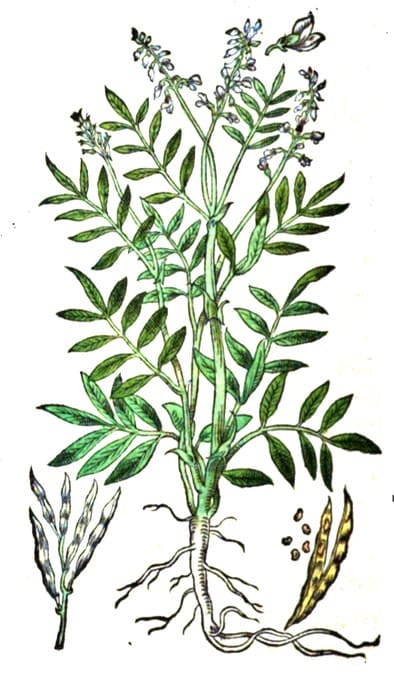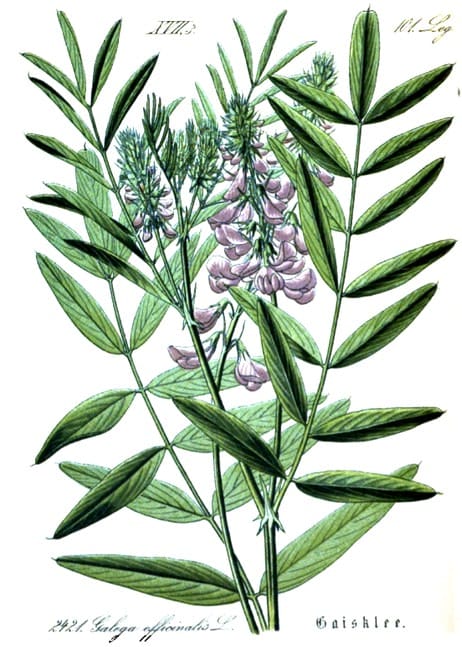Galega, Goat’s RueGoat’s Herb, French Lilac, Ruta Capraria |

|
 Krauterbuch, Lonitzer, 1578
Krauterbuch, Lonitzer, 1578 Kreutterbuch, Matthiolus, 1586
Kreutterbuch, Matthiolus, 1586 Flora von Deutschland (24), Kohler, 1886
Flora von Deutschland (24), Kohler, 1886Botanical name:
Galega officinalis
Salmon described two varieties: Common and Mountain Goat’s Rue
Parts used:
Herb
Temperature & Taste:
Neutral. Bitter, Pungent
Classification:
S. Worms and Parasites
Uses:
1. Clears Heat, Resists Poison:
-Sudorific and Alexipharmic, Epidemic diseases, Plague
-‘tried and tested preventative of the Plague’ (Matthiolus)
-Fevers with rashes; Small Pox and Measles
-Poison
-Snake Bite and bites of venomous beasts (Matthiolus); Rabid Dog bites, Scorpion Stings (Juice was given)
2. Regulates Blood Sugar:
-Diabetes
-according to some, it can raise or lower blood sugar depending on dose (Reinwein, Arch. F. Exp. Path and Pharm, 1927)
3. Settles Wind, Stops Spasms::
-Spasms, Convulsions, Epilepsy, Numbness, Trembling
-Vertigo, Migraine
-the Spirit revives Qi and is useful in ‘profound Melancholy’
-Lethargy, Drowsiness, Coma (Spirit of Galega)
-Epilepsy in children; one spoonful of the juice taken
4. Promotes Milk:
-benefits and promotes Milk
-children are said to have better well-being and are quieter (Schulz., Working and Application of the German Medicinal Plants)
-said to increase Breast size
-weight gain was noted in animals whose mother had been given Galega
-Cows fed Galega had up to 30% greater milk production
5. Kills Worms
-used for various Worm infestations
-Juice is strongest
6. Externally:
-Chilblains
-applied to the pulses for Fever
-applied to the Heart to protect the Heart from Poison.
-applied to putrid and foul Ulcers
-stops progress of Gangrene
-Infused Oil of the herb applied to the part and spine for Paralysis
-Infused Oil of the herb applied to Arthritis
Dose:
POWDER: 1–3 grams;
JUICE: 2–3 spoonfuls in wine
TINCTURE (1:10 in 45% alcohol): 30–60 drops
FLUID EXTRACT (1:1 in 25% alcohol): 1–2 mls. (15-30 drops)
ACID TINCTURE (Vinegar tincture): add enough to a vehicle to make it acid
SPIRIT: 1 spoonful diluted in water
Substitute:
Rue can sometimes be used for Goat’s Rue.
Main Combinations:
1. Against Poison and Infection:
i. the herb is boiled with flesh and eaten
ii. eaten as a Salad with Pepper, Salt, Vinegar and Oil (Salmon)
iii. Galega juice, Angelica Water (2–3 spoonfuls each)
iv. Galega, Zedoary, Contrayerva, Saffron, made into an Electuary with concentrated juice (‘Rob’) of Galega (Salmon)
-beaten herb fried, mixed with Mithridate, Bay berry powder and a little Aloe is applied over the region of the Heart against infection.
2. Diabetes, Goat’s Rue with Bean Pods
3. Epilepsy:
i. Galega with Rue and Peony
ii. Galega, Rue, Black Cherry, Linden flower
4. Promote Milk:
i. Goat’s Rue with Fenugreek
ii. Goat’s Rue with Fennel seed, Nettle
iii. Goat’s Rue with Balm, Fennel seed, Caraway, Aniseed, Nettle
5. To increase Breast Size:
i. Goat’s Rue, Fenugreek
ii. Goat’s Rue, Agnus Castus
6. Worms in children, beat the fresh herb to a paste and apply to the navel or lower abdomen.
Cautions:
1. Toxic in Overdose
2. Not used during Pregnancy.
Toxicity:
Animals that fed on Galega had shallow, rapid respiration. They had developed Hydrothorax and Edema of the Lungs. Galegine was believed to be responsible.
Main Preparations used:
Distilled Water, a Conserve of the Tops
|
1. POTENT ANTIBACTERIAL -Potent anti-bacterial activity has been shown in the ethanol (60%) extract against gram positive and gram negative. (Pundarikakshudu et al., J Ethnopharm., Sep, 2001) 2. INHIBITS PLATELET AGGREGATION: -Peptides formed from the amino acid content Inhibited Platelet Aggregation by 50%. (Atanasov et al., Folia Med,, 2002; Atanasov et al., J Med Food, Winter, 2002) |
3. BLOOD SUGAR: -When given to normal and genetically obese mice, Serum glucose was reduced in mice; serum insulin was reduced only in genetically obese mice. 4. WEIGHT-REDUCING EFFECT Galega was found to significantly reduce weight in normal and genetically obese mice when 10% w/w was included in the diet for 28 days. In normal mice the weight loss was reversible. In the obese mice there was persistent reduction in food intake over the 28 days. (Palit et al., J Pharm. Pharmacol., Nov, 1999) |
